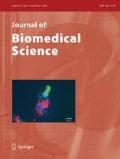Abstract
The mechanism of known receptor-mediated androgen effects on the endometrial stroma was studied in endometrial fibroblasts derived from human uterus. 17β-Estradiol (E) induced the expressions of androgen receptor (AR) mRNA, and predominantly increased the level of testosterone-binding sites (TBS) in uterine endometrial fibroblasts. The effect on the level of dihydrotestosterone-binding sites (DHTBS) was similar but smaller. This result suggests that the AR mRNA expressed might encode TBS, but probably not DHTBS. The TBS level increased by estrogen was down-regulated by testosterone (T) + E, but the AR mRNA expression increased by E was not down-regulated by E + T in the fibroblasts. Although the synthesis rate of AR was slightly increased (p<0.05) by E alone or E + T, the degradation rate of AR was significantly accelerated (p<0.05) by E + T in the fibroblasts. This result suggests that T might stimulate the metabolic rate of TBS, but does not inhibit the synthesis rate of AR mRNA to TBS in endometrial fibroblasts.
Similar content being viewed by others
References
Anderson JN, Clark JH, Peck EJ. Oestrogen and nuclear binding site determination of specific sites by [3H]oestradiol exchange. Biochem J 126:561–567;1972.
Arcari P, Martinelli R, Salvatore F. The complete sequence of a full-length cDNA for human liver glyceraldehyde-3-phosphate dehydrogenase: Evidence for multiple mRNA species. Nucleic Acids Res 12:9179–9189;1984.
Barbieri R. Steroid therapy; in Kistner RW (ed): Gynecology Principles and Practice. Chicago, Year Book Medical, 551–564;1986.
Bradford M. A rapid and sensitive method for the quantitation of microgram quantities of protein utilizing the principle of protein-dye binding. Anal Biochem 72:248–254;1976.
Burton K. A study of the conditions and mechanisms of the diphenylamine reaction for the colorimetric estimation of deoxyribonucleic acid. J Biochem 62:315–323;1956.
Chang C, Kokontis J, Liao S. Structural analysis of complementary DNA and amino acid sequences of human and rat androgen receptors. Proc Natl Acad Sci USA 85:7211–7215;1988.
Chomczynski P, Sacch N. Single-step method of RNA isolation by acid guanidium thiocyanate-phenol-chloroform extraction. Anal Biochem 162:156–159;1987.
Deslypere JP, Young M, Wilson JD, McPhaul MJ. Testosterone and 5α-dihydrotestosterone interact differently with the androgen receptor to enhance transcription of the MMTV-CA receptor gene. Mol Cell Endocrinol 88:15–22;1992.
Dorfman RI, Kincl FA, Ringold HJ. Antiestrogen assay of neutral steroids administered by subcutaneous injection. Endocrinology 68:17–24;1961.
Goebelsman U, Arce JJ, Thorneycroft IH, Mishell DR. Serum testosterone concentrations in women throughout the menstrual cycle and following HCG administration. Am J Obstet Gynecol 119:445–452;1974.
Gonalez-Diddi M, Komisaruk B, Beyer C. Differential effects of testosterone and dihydrotestosterone on the diverse uterine tissue of the ovariectomized rat. Endocrinology 91:1129–1132;1972.
Grino PB, Griffin JE, Wilson JD. Testosterone at high concentrations interact with the human androgen receptor similarly to dihydrotestosterone. Endocrinology 126:1165–1172;1990.
Lerner LJ. Hormone antagonist. Inhibitors of specific activities of estrogen and androgen. Recent Prog Horm Res 20:435–490;1964.
Liao S, Witte D. Autoimmune anti-androgen receptor antibodies in human serum. Proc Natl Acad Sci USA 82:8345–8348;1985.
Martini L. The 5α-reduction of testosterone in the neuroendocrine structures. Biochemical and physiological implications. Endocr Rev 3:1–25;1982.
Milgrom E, Alger M, Banlieu E-E. Progesterone in uterus and plasma. IV. Progesterone receptor(s) in guinea pig uterus cytosol. Steroids 16:741–754;1970.
Mooradian AD, Morley JE, Korenman SG. Biological actions of androgens. Endocr Rev 8:1–28;1987.
Noyes RW, Hertig AT, Rock J. Dating the endometrial biopsy. Fertil Steril 1:3–25;1950.
Ribeiro WO, Mishell DR, Thorneycroft IH. Comparison of the patterns of androstenedione, progesterone, and estradiol during the human menstrual cycle. Am J Obstet Gynecol 119:1026–1032;1974.
Scatchard G. The attraction of proteins for small molecules and irons. Ann NY Acad Sci 51;660–666;1979.
Tamaya T, Wada K, Nakagawa M, Misao R, Itoh T, Imai A, Mori H. Sexual dimorphism of binding site of testosterone and dihydrotestosterone in rabbit model. Comp Biochem Physiol 105A:745–749;1993.
Tan J, Joseph DR, Quarmby VE, Lubahn DB, Sar M, French FS, Wilson EM. The rat androgen receptor: Primary structure, autoregulation of its messenger ribonucleic acid, and immunocytochemical localization of the receptor protein. Mol Endocrinol 2:1276–1285;1988.
Valladores L, Minguell J. Characterization of a nuclear receptor for testosterone in rat bone marrow. Steroids 25:13–21;1988.
Walsh PC, Wilson JD. The induction of prostatic hypertrophy in the dog with androstanediol. J Clin Invest 57:1093–1097;1976.
Wolf D, Herzinger T, Hermeking H, Blaschke D, Horz W. The transcriptional and posttranscriptional regulation of human androgen receptor expression by androgen. Mol Endocrinol 7:924–936;1993.
Author information
Authors and Affiliations
Rights and permissions
About this article
Cite this article
Fujimoto, J., Nishigaki, M., Hori, M. et al. Effects of estradiol and testosterone on the synthesis, expression and degradation of androgen receptor in human uterine endometrial fibroblasts. J Biomed Sci 2, 160–165 (1995). https://doi.org/10.1007/BF02253067
Received:
Accepted:
Issue Date:
DOI: https://doi.org/10.1007/BF02253067



